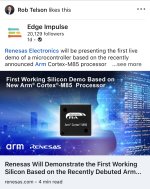Hi Bravo,
Apple's face-tracking invention uses an event camera. They would need some form of NN to identify the features as mentioned below. This could be software (CNN), their preferred option, or hardware. They also talk of using 2 event cameras for improved object movement recognition.
US2020273180A1 DEFORMABLE OBJECT TRACKING
View attachment 7867
View attachment 7868
1 .
A system comprising:
an event camera comprising a two-dimensional (2D) array of pixel sensors;
non-transitory computer-readable storage medium; and
one or more processors communicatively coupled to the non-transitory computer-readable storage medium and the event camera,
wherein the non-transitory computer-readable storage medium comprises program instructions that, when executed on the one or more processors, cause the system to perform operations, the operations comprising:
receiving a stream of pixel events output by the event camera, the event camera comprising a plurality of pixel sensors positioned to receive light from a scene disposed within a field of view of the event camera, each respective pixel event generated in response to a respective pixel sensor detecting a change in light intensity that exceeds a comparator threshold;
identifying features disposed on a deformable surface of the object using the stream of pixel events; and
generating a dynamic representation of the object, the dynamic representation comprising the features;
modifying the dynamic representation of the object in response to obtaining additional pixel events output by the event camera; and
outputting the dynamic representation of the object for further processing.
2 .
The system of claim 1, further comprising a second event camera, wherein modifying the dynamic representation of the object comprises:
identifying the features in the stream of pixel events from the event camera;
identifying the features in a second stream of pixel events from the second event camera; and
tracking three dimensional (3D) locations of the features based on correlating the features identified from the streams of pixel events from the event camera and the features identified from the second stream of pixel events from the second event camera.
As we know, Akida can perform the CNN function, or rather the CNN data can be adapted for use in Akida in a far more efficient manner than running the CNN process on a CPU.
The fact that they mention SNNs in passing does not of itself indicate that Apple are aware of Akida, as the most widely known SNN in 2018 would have been analog.
So, yes, Akida could be used to advantage in Apple's face recognition patent





